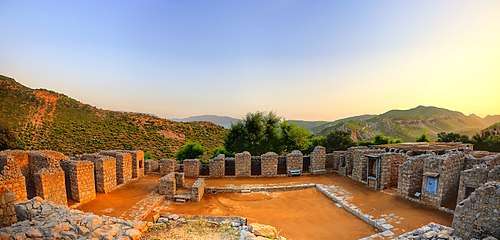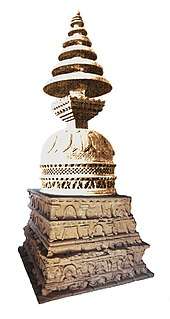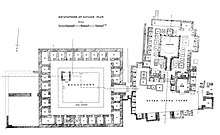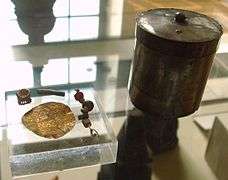Jaulian
 A view of the ruins of Jaulian (monastery area) | |
 Shown within Pakistan | |
| Location | Haripur District, Khyber Pakhtunkhwa |
|---|---|
| Coordinates | 33°45′56″N 72°52′30″E / 33.76552°N 72.87498°ECoordinates: 33°45′56″N 72°52′30″E / 33.76552°N 72.87498°E |
| Type | Monastery |
| History | |
| Founded | 2nd century CE |
| Abandoned | mid 5th century CE |
| Cultures | Kushan, Kidarite |
| Site notes | |
| Archaeologists | Sir John Marshall |
| Official name | Taxila |
| Criteria | iii, iv |
| Designated | 1980 |
| Reference no. | 139 |
Jaulian (Urdu: جولیاں; meaning Seat of Saints[1]) is a ruined Buddhist monastery dating from the 2nd century CE,[2] located in Pakistan. Jaulian is located in Haripur District, Khyber Pakhtunkhwa province, near the provincial border with Punjab and the city of Taxila.
Jaulian, along with the nearby monastery at Mohra Muradu, form part of the Ruins of Taxila – a collection of excavations that were inscribed as a UNESCO World Heritage Site in 1980.
Location
Jaulian is located on a hill 100 metres above the nearby modern village of Jaulian. The cities of Rawalpindi and Islamabad are approximately 35 km and 45 km to the southeast, respectively and situated near Khanpur Taxila road; a picnic place near Khanpur Dam. Jaulian is located near the Mohra Muradu monastery, and the ancient Taxilan city of Sirsukh. Moreover, Piplan Remains, Badalpur Stupa and Jinnah Wali Dheri Stupa are nearby places.
History
Jaulian was built by the Kushans in the 2nd century CE – around the same time as the nearby Mohra Muradu[3] Jaulian, along with the rest of Ancient Taxila, was devastated in the 450s CE during the invasion of the White Huns, and later abandoned. Subsequent rulers, such as the Hun King Mihirakula, persecuted the region's Buddhists,[4] and the site never recovered.
Excavations
The ruins at Jaulian are situated on a hill top, and consist of: a main central stupa, 27 peripheral smaller stupas, 59 small chapels displaying scenes from the life of Buddha, and two quadrangles around which monastic living quarters were arranged. The form and building of Jaulian is similar to that of the nearby Mohra Muradu.[3]
Main stupa


The main stupa at Jaulian was much smaller than that of Mohra Muradu or the Dharmarajika Stupa,[3] and is badly damaged. It was extensively coated in stucco plaster, as are almost all the sculptures and architectural details.[3] Despite the use of an easily moldable material, the quality of decoration at Jaulian is considered to be less impressive than that of Mohra Muradu.[3] The original plaster is preserved at some places.
The man stupa is surrounded by 21 smaller "votive stupas" that contained religious iconography – though some posit that some of the votive stupas were actually built as tombs for revered monks. The statues located in the votive stupas are mostly preserved; though a number of have been removed and are housed in museums.the original fabric of the main stupa itself which stands in the middle of the upper court
A statue of Buddha in a votive stupa with a hole in the navel was called the "Healing Buddha". Pilgrims would put their fingers in the icon's navel, and pray for cures of various ailment. A 5th century inscription preserved under the statue shows that it was given by a friar Budhamitra Dharmanandin.[6]
Monastery

The monastery at Jaulian is similar to that of nearby Mohra Muradu.[3] Jaulian monastery was a two-level building that contained 28 students' rooms on the first floor, and 28 more on the second floor. The two levels are connected by stone stairs which are still preserved. Some of the rooms contain preserved statues of the Buddha. Each room had a niche to hold lamps, and a window offering a source of fresh air and natural light. The windows were designed to be narrower at the outer edge, of and larger at the inner edge in order guard against wild animals. The rooms were plastered and decorated with plasterwork and paintings.
As was common at other large monasteries in the Gandhara region such as Takht-i-Bahi and Dharmarajika, a section of the monastery was set aside specifically for the production of Buddhist manuscripts, typically on birch bark,[3] a highly perishable material.
The monastery further contained a large pool that was used for washing, and a kitchen. A stone for grinding spices is well- preserved at the site, as well as two stone mills that were used to grind grains.
World's first university
Jaulian's monastery formed part of what some consider to be the world's oldest university. Students came to study and consult texts from throughout the Indian subcontinent and as far as Central Asia, Southeast Asia and China. Although, the important antiques have been shifted from Jaulian to Taxila Museum, however, importance of this place is very much for the visitors.
Gallery
 A view of the Jaulian ruins
A view of the Jaulian ruins- A votive Stupa at Jaulian
- "Healing Buddha," Buddha with a navel hole
- An inscription under a statue at Jaulian
 Devotee in foreign dress (Indo-Scythian)
Devotee in foreign dress (Indo-Scythian)- Stairs to the second floor
- The window of a students room
- The pool for ritual washings
 Stupa-shaped reliquary from Jaulian
Stupa-shaped reliquary from Jaulian- A mill for grinding grains
 A silver reliquary recovered from Jaulian, now on display at the British Museum
A silver reliquary recovered from Jaulian, now on display at the British Museum Jaulian is located to the northeast of Sirkap
Jaulian is located to the northeast of Sirkap
See also
References
- ↑ "Taxila". Ancient History Encyclopedia. 23 July 2015. Retrieved 23 June 2017.
- ↑ Rashid, Salman (2001). The Salt Range and the Potohar Plateau. Sang-e-Meel Publications. ISBN 9789693512571. Retrieved 23 June 2017.
- 1 2 3 4 5 6 7 Samad, Rafi U. (2011). The Grandeur of Gandhara: The Ancient Buddhist Civilization of the Swat, Peshawar, Kabul and Indus Valleys. Algora Publishing. ISBN 9780875868592.
- ↑ Behrendt, Kurt A. (2004). Handbuch der Orientalistik. BRILL. ISBN 9789004135956.
- ↑ After Le Huu Phuoc, Buddhist Architecture, Grafikol 2009, p.178
- ↑ Marshall, John. Taxila: An Illustrated Account of Archaeological Excavations Carried Out at Taxila Under the Orders of the Government of India between the years 1913 and 1934. p. 372.
External links
| Wikimedia Commons has media related to Jaulian. |